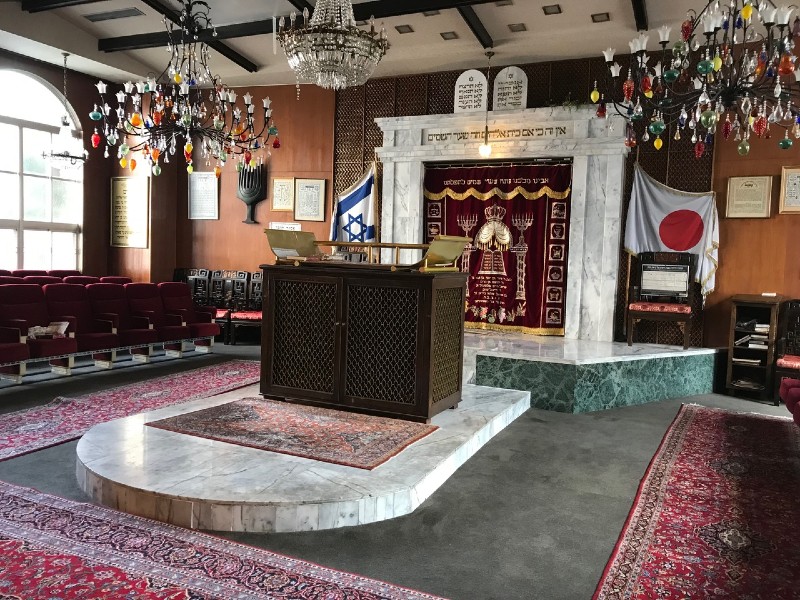Finding threads of Jewish history can sometimes feel like a treasure hunt. Wars, natural disasters and fading memories can destroy physical records and the ability to reconstruct history. However, the dedication of a few willing to preserve the past can make it possible to piece together a handful of history chapters.
On a recent trip to Kobe, Japan, my husband and I were fortunate to accompany Prof. Takayoshi Iwata as he pointed out bits and pieces of Jewish history. Iwata, a retired school principal, was the former director of the Kazamidori House, a popular tourist spot. He simultaneously taught college-level classes focusing on Kobe’s history. A visit to the Simon Wiesenthal Center in Los Angeles ignited his interest in the Holocaust, and thereafter, he researched the Jews of Kobe. Acknowledged as an expert, he authored Japanese books about the Jews who lived in Kobe as well as the history of Kobe.
In pre-Second World War Europe, Jews who heeded the warnings searched for avenues of escape. A few thousand were able to connect with Chiune Sugihara, a Japanese diplomat stationed in Lithuania. He issued transit visas to Polish Jews who sought his assistance. Many of these refugees, along with other Jews, sailed in boats headed to Tsuruga, Japan.
After arriving in Japan, an unknown number were transported by train to Kobe and Yokohama. In Kobe, the small Jewish community welcomed these immigrants who had limited resources and few offers for safe havens. The Jews who made up the existing Jewish community had found their way to Kobe after the major Japanese ports were open to foreign traders in the mid-19th century.
Iwata’s research has revealed that Kobe’s German population in the 1930s and 1940s was small, and there was no evidence of anti-Semitism in the town. The local authorities allowed the Jewish refugees to remain in Kobe under special conditions even though their short-term visas had expired and they were legally subject to deportation.
By taxi, we accompanied Iwata up the hilly roads of Kobe. He wanted to show us some locations where the pre-war Jews resided in cramped quarters. While the living conditions were far from ideal, these Jews were far better off than their relatives and friends who were left behind in Europe.
Our first stop was in a remote area of Kobe called Umadome. Standing outside a western-style brown and white multi-story home set upon a rocky platform, Iwata mentioned that recent research indicates that 39 refugees had resided in the house.
We hopped back into the taxi and headed up a narrow, steep hill to an area called Kitano-cho. As we walked through this quiet residential neighbourhood, Iwata shared snippets from oral testimonies about the people who sought refuge here. He pointed out the former residences of Rahmo Sasson and Isaac Alfred Ailion. Far removed from their home countries, European Jewish refugees had no idea what was happening during the Nazi reign.
Iwata treated us to a panoramic view of the city at the Shinto shrine Tenman Zinzya. We accessed this vantage point by climbing up stone steps with high risers.
During the Second World War, the Jewish community’s centre was located near another shrine, the Ichinomiya Shinto Shrine. During the bombings, just about everything was destroyed except for a few shrines. We could only imagine the place where thousands of Jewish refugees were supported by the American Jewish Joint Distribution Committee (JDC). As I have seen in other locations, the JDC provided food, shelter and resources for war refugees. We stood next to a dull, worn-out sign stating, “Center Jewish Community of Kansai.” Iwata referred to this site as JEWCOM.

On April 20, 2020, a commemorative signboard will be installed on the site of JEWCOM. The city of Kobe will be covering part of the cost. Iwata has been asked to write the wording for this signboard. Honoured guests at the celebration ceremony will include Kobe’s mayor, a representative of the Foreign Ministry, a diplomat from the Polish Embassy and a survivor saved by Sugihara.
READ: BEAUTIFUL STOCKHOLM THROUGH JEWISH EYES
At the nearby shrine, we met with the Shinto priest Oomi Yamamoir. He was born in 1937 and raised at the small Ichinomiya Shinto Shrine, which dates back to approximately 300 CE. He studied the history of Jews before the Second World War and started collecting photos of the Jewish community, including a few provided by the Hyogo Prefectural Museum. Yamamoir shared a notebook filled with black and white images depicting Jewish life in the 1940s.
As the war progressed, the safety of the Jews was not guaranteed in Kobe. The Jews who were unable to obtain visas for another country were deported to Japanese occupied Shanghai, where they remained far removed from the Holocaust.
Two tangible aspects of Jewish life remain visible in Kobe today. The Ohel Shelomo Synagogue currently serves the small Jewish community. Even though we had an appointment with, American born, Rabbi Shmuel Vishedsky, he was unfortunately detained due to a congregant’s emergency. He relocated to Kobe six years ago because the congregation needed a leader. It was a good fit because his brother-in-law, Rabbi Mendi Sudakevich is the Chabad director in Tokyo.
Without a guided tour, we merely strolled around inside. I eventually connected with Rabbi Vishedsky by e-mail. He encourages visitors to consider attending services and to join with the local community at synagogue meals. However, it is always recommended to contact international synagogues before arrival.
In order to reach the Foreigners’ Cemetery before it closed, it was not possible to wait for the rabbi. Iwata had arranged special access with the city to enter, so we could not be late. The taxi wound its way through forested terrain filled with switchbacks and deep ravines. It was a bit odd to drive through a nature preserve to reach the Shiogahara Foreign Cemetery which is the final resting place for approximately 2,100 people, including 127 Jewish graves. Records indicate that the first Jew, Alfred Singleton, was buried there on Oct. 27, 1869.
Drops of rain started splashing on the ground as we entered a metal gate decorated with Magen Davids. The rolling landscape was conducive to a tiered burial arrangement. Older gravestones tended to be engraved in Hebrew, while the more recent graves were in English or a combination of English and Hebrew. Adjacent plots of land partitioned by fences contained Muslim and Christian gravestones.
Like many good mysteries, we returned to our cruise ship with more questions than answers. If we could read Japanese, the missing facts might fall into place after reading the two books that Iwata handed to us at the port. Perhaps, one day, more points will be revealed to an English-speaking audience.
